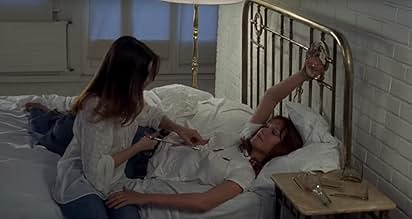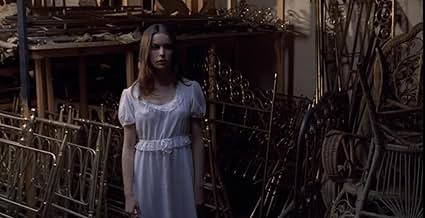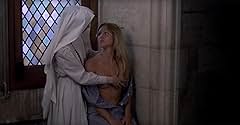Das beständige Gleiten der Begierde
Originaltitel: Glissements progressifs du plaisir
IMDb-BEWERTUNG
6,1/10
1507
IHRE BEWERTUNG
Eine junge Frau, die des Mordes verdächtigt wird, versinkt in einer dunklen erotischen Fantasie, angetrieben von ihren verdrehten Begierden in diesem psychologischen Drama.Eine junge Frau, die des Mordes verdächtigt wird, versinkt in einer dunklen erotischen Fantasie, angetrieben von ihren verdrehten Begierden in diesem psychologischen Drama.Eine junge Frau, die des Mordes verdächtigt wird, versinkt in einer dunklen erotischen Fantasie, angetrieben von ihren verdrehten Begierden in diesem psychologischen Drama.
- Regie
- Drehbuch
- Hauptbesetzung
Michael Lonsdale
- Le magistrat instructeur
- (as Michel Lonsdale)
Hubert Niogret
- Le photographe
- (Nicht genannt)
Alain Robbe-Grillet
- Un passant dans la rue
- (Nicht genannt)
Catherine Robbe-Grillet
- Une soeur dans la rue
- (Nicht genannt)
Frank Verpillat
- L'homme qui ouvre la porte
- (Nicht genannt)
Bob Wade
- Le fossoyeur
- (Nicht genannt)
Empfohlene Bewertungen
Not as instantly likable as Trans-Europ-Express but just as beautifully photographed, this time in colour, and if we do not follow every nuance at least we believe the writer/director does. So there is no suggestion that we are being led down any garden path, just that Robbe-Grillet's obsessions are maybe not quite the same as our own. This seemed fine at first and as with the aforementioned film, I was happy enough with the various 'truths' being offered and didn't panic. As things become more religious, however, with suggestions of witchcraft, I felt myself becoming more distant. This may work differently for others but I just wasn't interested enough in that side of things. Priests, nuns and catholic guilt are all very fine but are not one of my concerns. Has to be said that the gorgeous ladies here are perfectly happy to remove their clothes and the usual S&M trappings we associate with the director are much to the fore. Not all bad then.
Before the opening credits were over, I could tell that this was going to be an impenetrable piece of pretentious arthouse garbage. I don't usually like to use the word pretentious - it's a lazy epithet - but in this case, it has never been more apt: the whole film is up itself.
I watched it on the mistaken belief that it was a horror film; it's not. Exactly what it is is anyone's guess - the surreal story is so abstract and the treatment so avant-garde that it's hard to work out what director Alain Robbe-Grillet's intention was.
If the film wasn't French and from the '70s, I would have guessed that the whole thing was a parody of French '70s arthouse cinema, but it isn't: this is the real deal. Perhaps if the film was condensed to twenty minutes of the weirdest moments (whilst retaining the gratuitous nudity, of course), I wouldn't hate it quite as much as I do, but at a whopping 105 minutes, it is an excruciatingly, dull watch.
Due to a technical hitch, I had to view the last twenty minutes or so without subtitles, but it didn't make a whole lot of difference: I had long given up trying to make sense of it all.
1/10. One of the worst films I have ever seen.
I watched it on the mistaken belief that it was a horror film; it's not. Exactly what it is is anyone's guess - the surreal story is so abstract and the treatment so avant-garde that it's hard to work out what director Alain Robbe-Grillet's intention was.
If the film wasn't French and from the '70s, I would have guessed that the whole thing was a parody of French '70s arthouse cinema, but it isn't: this is the real deal. Perhaps if the film was condensed to twenty minutes of the weirdest moments (whilst retaining the gratuitous nudity, of course), I wouldn't hate it quite as much as I do, but at a whopping 105 minutes, it is an excruciatingly, dull watch.
Due to a technical hitch, I had to view the last twenty minutes or so without subtitles, but it didn't make a whole lot of difference: I had long given up trying to make sense of it all.
1/10. One of the worst films I have ever seen.
SPOLILERS...kind of.
There is so much going on in this movie it's hard to know where to start. The key is a line where the girl's lawyer says, "All who approach you are perverts, insane. But it's all in your little mind." Looked at in that context, the "plot" means nothing since it's more about thoughts than action.
That said, the central character, called only "The Prisoner" is arrested for the murder of her lover, Nora. The two are in a Domme/sub, BDSM relationship with The Prisoner portrayed as the Dominant.
Many characters take on double meanings. The police, it seems to me, represent the author, asking supposedly meaningless questions that would only make sense if you were creating a rich background life for a character such as The Prisoner. One of the cops, rather than documenting the crime, blatantly records the themes of the movie: "Themes of broken bottles". Bottles stand in for the wombs and this refers the broken mother/daughter relationship between...
...The Prisoner and Nora. Nora is her mother. The same cop that records themes rather than evidence, has a scene where he recites words while writing and researching something (probably the screenplay being filmed) in the bed Nora was killed in. This is crosscut with The Prisoner being show objects and free associating. The cop says "parricide". The Prisoner says "disassociation".
Throughout the movie, Nora seems the submissive except for one scene - when the Prisoner sells herself to a man looking for deviant sex. She takes them up to the room. Nora lounges in a window seat. Stepping back, the actual "plot" revolves around Mother Nora selling and sexually abusing her daughter.
Her court-appointed lawyer (read "protector") is played by the same actress that plays Nora. At first, Nora acts like the mother The Prisoner wants/needs - strict and no-nonsense. But, The Prisoner's insanity seduces Lawyer/Mom/Nora, or at least that's the scenario The Prisoner dreams up. The Prisoner ends up killing Lawyer/Mom/Nora in very similar circumstances.
Plot-wise, the police find that Nora was NOT killed by the prisoner. They come to tell The Prisoner this and find The Lawyer dead. "We'll have to start over", the cop says.
What the director presents to us is a portrait of The Prisoner, deep in the clutches of her disassociation, creating a world that's easier for her to live in - where she controls her mother, dressing her as a manikin and, just by thinking about it, causes people to die. It's complex, gorgeous and, if not actual porn, has enough nudity to satisfy that requirement if that's what you're looking for.
There is so much going on in this movie it's hard to know where to start. The key is a line where the girl's lawyer says, "All who approach you are perverts, insane. But it's all in your little mind." Looked at in that context, the "plot" means nothing since it's more about thoughts than action.
That said, the central character, called only "The Prisoner" is arrested for the murder of her lover, Nora. The two are in a Domme/sub, BDSM relationship with The Prisoner portrayed as the Dominant.
Many characters take on double meanings. The police, it seems to me, represent the author, asking supposedly meaningless questions that would only make sense if you were creating a rich background life for a character such as The Prisoner. One of the cops, rather than documenting the crime, blatantly records the themes of the movie: "Themes of broken bottles". Bottles stand in for the wombs and this refers the broken mother/daughter relationship between...
...The Prisoner and Nora. Nora is her mother. The same cop that records themes rather than evidence, has a scene where he recites words while writing and researching something (probably the screenplay being filmed) in the bed Nora was killed in. This is crosscut with The Prisoner being show objects and free associating. The cop says "parricide". The Prisoner says "disassociation".
Throughout the movie, Nora seems the submissive except for one scene - when the Prisoner sells herself to a man looking for deviant sex. She takes them up to the room. Nora lounges in a window seat. Stepping back, the actual "plot" revolves around Mother Nora selling and sexually abusing her daughter.
Her court-appointed lawyer (read "protector") is played by the same actress that plays Nora. At first, Nora acts like the mother The Prisoner wants/needs - strict and no-nonsense. But, The Prisoner's insanity seduces Lawyer/Mom/Nora, or at least that's the scenario The Prisoner dreams up. The Prisoner ends up killing Lawyer/Mom/Nora in very similar circumstances.
Plot-wise, the police find that Nora was NOT killed by the prisoner. They come to tell The Prisoner this and find The Lawyer dead. "We'll have to start over", the cop says.
What the director presents to us is a portrait of The Prisoner, deep in the clutches of her disassociation, creating a world that's easier for her to live in - where she controls her mother, dressing her as a manikin and, just by thinking about it, causes people to die. It's complex, gorgeous and, if not actual porn, has enough nudity to satisfy that requirement if that's what you're looking for.
Although this was made before writer/film director Alain Robbe-Grillet's slightly less obscure "Playing with Fire", it is even more deranged, surrealistic, perverse, and non-narrative than that one. It kind of resembles the early French surrealist films of Luis Bunuel and Salvador Dali except that it is in color and contains Robbe-Grillet's usual manipulation of time and narrative (see "Last Year at Marienbad" or any of his novels). The film seems to be about a young student who is questioned by both police and religious authorities after her roommate is found bound and murdered. Except it's not clear that her roommate is actually a real person or just a mannequin in a bizarre art piece, and it's not even really clear whether she's being questioned after or BEFORE she commits this "murder".
Like several other French filmmakers of this era, Robbe-Grillet got away with making such an experimental, non-narrative feature by adding softcore sexploitation elements, but he doesn't "sell out" as much to the sexploitation angle as some of his country-men like Jean Rollin or Walerian Borowzyx (which might be one of the reason his films are a lot harder to find today). There is very little straight erotic sex in this film; instead there is a kind of extreme polymorphous perversity that at times is pretty disturbing. There are A LOT of scenes of both women and female mannequins in sadomasochist/bondage poses and splattered with blood or red paint. There is also a little bit of "Lolita-ism". The main star, Anicee Alvina, is a beautiful girl with a great body (a long, strange scene where she covers her glorious full-frontal nakedness with red paint and makes "self-portraits" by pressing herself against the white walls of her cell is especially memorable), but she was only in her late teens/early 20's here and could certainly pass for younger, especially since Robbe-Grillet often has her dressed (when he has her dressed at all, that is) in a "baby doll" outfit or a Catholic schoolgirl uniform.
Aside from Alvina this movie doesn't have the "name" cast of "Playing with Fire" (i.e. Sylvia Kristel, Agostina Belli). It does, however, feature an early appearance by Isabelle Huppert, who is now probably THE most respected actress in France. (This is kind of like finding out that Meryl Streep was once in a softcore porno "art" film early in her career, but then Huppert has always been a much more daring actress than Streep). I'm not sure which character Huppert plays exactly--I think she's one the protagonist's school-mates since she was would have been even younger than Alvina back then.
Very interesting film--I'd recommend it to any fan of arty, weird, and/or perverted films.
Like several other French filmmakers of this era, Robbe-Grillet got away with making such an experimental, non-narrative feature by adding softcore sexploitation elements, but he doesn't "sell out" as much to the sexploitation angle as some of his country-men like Jean Rollin or Walerian Borowzyx (which might be one of the reason his films are a lot harder to find today). There is very little straight erotic sex in this film; instead there is a kind of extreme polymorphous perversity that at times is pretty disturbing. There are A LOT of scenes of both women and female mannequins in sadomasochist/bondage poses and splattered with blood or red paint. There is also a little bit of "Lolita-ism". The main star, Anicee Alvina, is a beautiful girl with a great body (a long, strange scene where she covers her glorious full-frontal nakedness with red paint and makes "self-portraits" by pressing herself against the white walls of her cell is especially memorable), but she was only in her late teens/early 20's here and could certainly pass for younger, especially since Robbe-Grillet often has her dressed (when he has her dressed at all, that is) in a "baby doll" outfit or a Catholic schoolgirl uniform.
Aside from Alvina this movie doesn't have the "name" cast of "Playing with Fire" (i.e. Sylvia Kristel, Agostina Belli). It does, however, feature an early appearance by Isabelle Huppert, who is now probably THE most respected actress in France. (This is kind of like finding out that Meryl Streep was once in a softcore porno "art" film early in her career, but then Huppert has always been a much more daring actress than Streep). I'm not sure which character Huppert plays exactly--I think she's one the protagonist's school-mates since she was would have been even younger than Alvina back then.
Very interesting film--I'd recommend it to any fan of arty, weird, and/or perverted films.
A young woman is interrogated by the police and the judges,suspected of being a modern witch.The girl who shared her apartment has been found dead with a pair of scissors impaled through her heart,as she lay attached to the bedposts.Apparently,the girl does have powers,to make all people around her fall prey to her spell,glissing progressively into desire,lust and the unknown.Alain Robbe-Grillet has to be one of the most innovative French novelists and film-makers.His "Successive Slidings of Pleasure" is a wonderful film that contains plenty of surreal moments and lots of sleaze.The movie itself is truly unique and bizarre,so fans of unusual European art-house exploitation won't be disappointed.So if you are a fan of Jean Rollin's works give this one a look.This is my first journey into Alain Robbe-Grillet's visions and I'm highly impressed!
Wusstest du schon
- WissenswertesItalian censorship visa # 64458 delivered on 2 May 1974.
- Zitate
Alice, the prisoner: Above all, do not scream...
- VerbindungenFeatured in Der Ruf der Gradiva (2006)
Top-Auswahl
Melde dich zum Bewerten an und greife auf die Watchlist für personalisierte Empfehlungen zu.
- How long is Successive Slidings of Pleasure?Powered by Alexa
Details
- Erscheinungsdatum
- Herkunftsland
- Sprache
- Auch bekannt als
- Successive Slidings of Pleasure
- Produktionsfirmen
- Weitere beteiligte Unternehmen bei IMDbPro anzeigen
- Laufzeit
- 1 Std. 45 Min.(105 min)
- Sound-Mix
- Seitenverhältnis
- 1.66 : 1
Zu dieser Seite beitragen
Bearbeitung vorschlagen oder fehlenden Inhalt hinzufügen













